Utah County Birders Newsletter
|
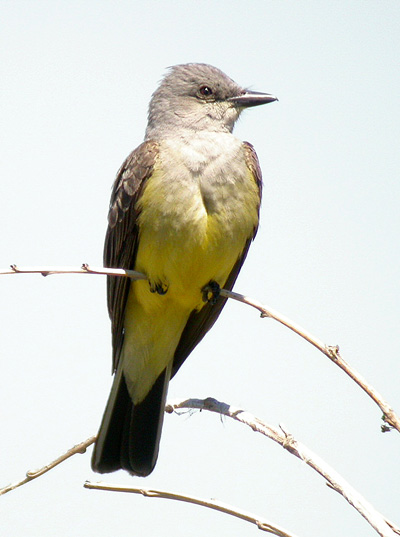 |
|
Western Kingbird -
photo by Milt Moody |
Merrill's Musings
By Merrill Webb
Tyrant Flycatchers
Nineteen species of the family Tyrannidae have been documented in Utah. On the
official state checklist four of these (Least Flycatcher, Eastern Phoebe, Great
Crested Flycatcher and Scissor-tailed Flycatcher) are listed as either
“occasional” or “accidental”. One (Brown-crested Flycatcher) is listed as “rare
summer” because it is found typically only in the southwestern corner of
Washington County. That leaves fourteen species of flycatchers that can be
looked for in eight of the 29 counties of Utah for the birding challenge.
However, it is not as simple as it appears (as has been pointed out to me by
some of you participating in this year’s challenge). Five of these fourteen
flycatchers belong to the genus Empidonax. Quoting from my 1961 copy of Roger
Tory Peterson’s A Field Guide to Western Birds, “Small flycatchers in w. N.
America share in common the characters of dark back, light underparts, light
eye-ring, and 2 white wing-bars.......They are more readily identified by
nesting habits, habitat, and voice than by subtle color differences.
Unfortunately, in migration they may depart from typical habitat and they seldom
sing their names. Collecting has proven that it is nearly impossible to name
many individuals in the field, even in the spring, so the wise field man usually
lets most of them go as just Empidonaxes.” Then, from my 1980 edition of
Peterson’s A Field Guide to the Birds, the following statement, “Five small
flycatchers in our area share the characters of light eye-ring and 2 whitish
wing bars. When breeding, they are readily separated by voice, habitat, and way
of nesting…..In migration they seldom sing, so we are forced to let most of them
go simply as Empidonax flycatchers.” From my 1990 edition of Western Birds, by
Peterson, he adds, “….If you wish the challenge of trying to name them in
migration, study Kenn Kaufman’s Field Guide to Advanced Birding, but first know
each one well when it is on its nesting ground, singing and calling.”
The months of May and June are critical months for getting out and finding these
“empids”, as well as the other flycatchers. Below is a list of habitats and
counties where flycatchers are most likely to be found during breeding season.
This data is based on the Utah Bird Distribution: Latilong Study (1983), which
in many respects is outdated, and my own experience with this group of birds.
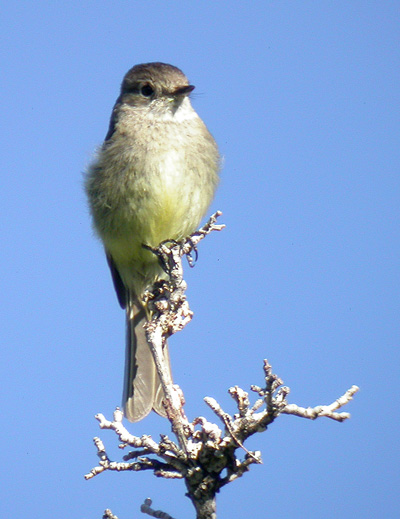 |
|
Dusky Flycatcher - photo by Milt
Moody |
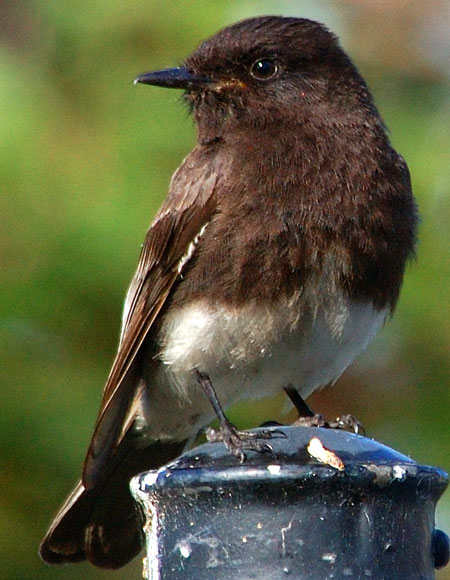 |
|
Black Phoebe - photo by Lu
Giddings |
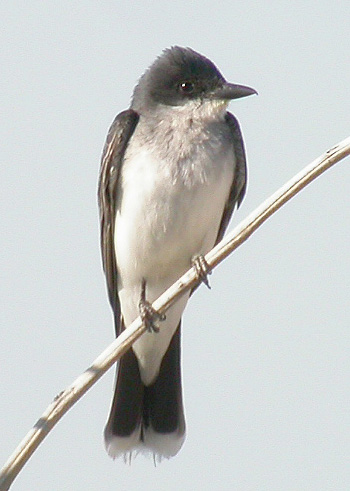 |
|
Eastern Kingbird - photo by Milt Moody |
Olive-sided Flycatcher - (high coniferous forest); counties: Davis,
Garfield, Kane, Morgan, Salt Lake, Sanpete, Summit, Tooele, Utah, Wasatch and
Washington.
Western Wood Pewee - (deciduous forest and river groves); counties:
almost all counties in Utah.
Willow Flycatcher - (willow thickets); counties: Box Elder, Cache, Davis,
Garfield, Kane, Sanpete, Tooele, Utah, Wasatch, and Washington.
Hammond’s Flycatcher - (high coniferous forest); counties: Box Elder,
Cache, Sanpete, Tooele, Utah, Wasatch; and in migration, Davis and Washington.
Gray Flycatcher - (sagebrush, pinion, and juniper); counties: Iron, Kane,
Juab, Millard, Tooele, Uintah, Utah; migration, Davis and Washington.
Dusky Flycatcher - (mountain chaparral); counties: Beaver, Box Elder,
Cache, Davis, Iron, Juab, Kane, Millard, Salt Lake, Tooele, Utah, and Wasatch.
Cordilleran Flycatcher - (moist woods, mixed or conifer forests, shady
canyons); counties: Beaver, Box Elder, Cache, Iron, Kane, Salt Lake, Sanpete,
Utah and Washington.
Black Phoebe - (shady streams, walled canyons, towns near water);
counties: Washington, Kane, and San Juan.
Say’s Phoebe - (scrub, canyons, ranches and mostly open areas); counties:
widespread distribution, in most Utah counties.
Vermilion Flycatcher - (wooded streams in arid country, golf courses);
counties: Kane, (rarely in San Juan) and Washington.
Ash-throated Flycatcher - (semi-arid country, deserts, pinion-juniper,
open woods); counties: Beaver, Box Elder, Iron, Juab, Kane, Millard, Sanpete,
Tooele, Uintah, Utah, Washington.
Brown-crested Flycatcher - (cottonwood-riparian areas); Washington.
Cassin’s Kingbird - (semi-open high country, pine-oak mountains);
counties: Kane, San Juan, Washington, Wayne.
Western Kingbird - (agricultural areas, semi-open country, roadsides);
counties: most counties in Utah.
Eastern Kingbird - (river groves, farms, Provo airport dike, fencerows);
counties: Box Elder, Duchesne, Uintah, Utah.
Now all that is necessary is to be able to identify their songs in their favored
habitat. The Stokes Field Guide to Bird Songs (Western Region) with recordings
by Kevin Colver from Elk Ridge contains every one of the songs of the birds
listed above, and most of them were recorded in Utah.
Based on the above information the best counties in which to find eight species
of flycatchers during the breeding season are the following: Washington, Kane,
Utah, Tooele and Sanpete followed closely by Davis, Iron and Millard. During
migration these species can be found in other counties, but it is more
challenging to identify them because they are not singing and are not in their
typical habitat.
Recognizing that about half of these counties are in southern Utah, and because
of increased gasoline prices, I am suggesting that instead of eight counties for
the challenge, the number be reduced to four—that would also apply to warblers
and sparrows. And, in terms of adding eight new species in eight states, the
number should be reduced by half as well. For those of you who have already
accomplished the state requirements we can make some substitutions on an
individual basis.
If the price of gas continues to escalate (four dollars per gallon) I am in
favor of eliminating the whole idea of a challenge for this year. I am not
suggesting that these requirements for this year’s challenge are unattainable,
far from it—just that it is becoming too expensive to continue.
For those of you who have read this far, and who have been making a
conscientious effort toward completing the challenge, please be prepared to give
me your input at the next meeting. Be thinking of some alternatives that pertain
just for Utah County, and give them to me in writing before the meeting.
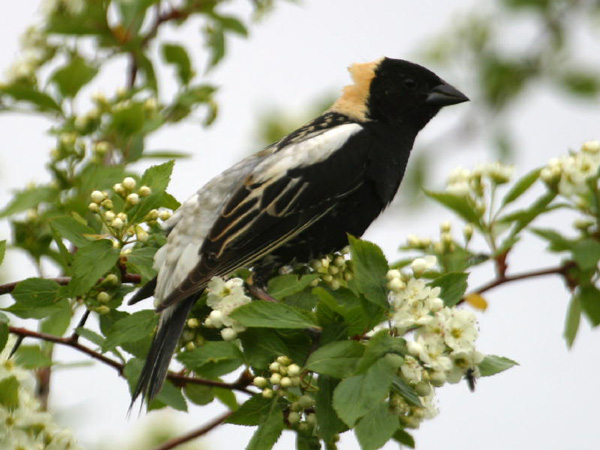 |
|
Bobolink - photo by Jack Binch |
Bird of the
Month
Bobolink
Class: Aves
Order: Passeriformes
Family: Icteridae
Genus: Dolichonyx
Species: Dolichonyx oryzivorus
Any trip to the fields north of Goshen during breeding season is not complete unless a birder can tick off the Bobolink on his checklist. Its main territory is north and east of Utah, but we are more than happy to have a few patches of grassland near us where it also breeds.
This black 7” wonder with the conical beak, has white patches on his shoulders and rump and a buff nape and back of head. (I think he needs the assistance of a personal shopper myself, or at least an honest friend who can help him get a cap a few sizes larger so it covers all his head and not just the back. I’ll bet he bought that one at a garage sale.) The Bobolink has two complete molts each year. All the new feathers it produces on its wintering grounds have yellow tips making it look much liked a non-breeding bird. But in time the tips wear off and the plumage is left with its dramatic breeding coloring. The Bobolink is dichromatic, meaning the male and female look distinctly different. The female looks more like a sparrow than it does its mate, but only during breeding season.
The male wins his mates in the usual blackbird fashion. He drops his head, ruffles his neck feathers, fans his tail, arches his wings displaying his prominent white shoulder patches, and the females fall at his feet, so to speak. Federal marshals do not interfere with this polygamous bird. Older Bobolinks may have as many as four nesting females in their territory, but most of their time and attention is devoted to the first family they produce, taking care of the others as time and resources permit. Excuse me! That is a lousy show of responsibility!! Aha, read on. They also engage in cooperative breeding, a seeming rarity among long distant migrants. This is where more than two adults participate in the feeding of the young at a single nest. The extra adults may be male or female, may be previous offspring from one of the adults, may actually be the birth parent of one or more of the young on the nest, or may have lost their own young and still be ruled by their biological urge to feed. The Bobolink’s clutch size is four to six eggs and their nest is on the ground leaving it vulnerable to early field mowing.
The Bobolink’s flight is strong and undulating. They migrate to southwestern Brazil, Paraguay and northern Argentina, with some stopping off in Peru and Chile, a round trip of up to 12,500 miles. They migrate at night in flocks called chains, guided by the earth’s magnetic fields and the position of the stars. Before their overseas flight, they fatten up on food in the southeastern United States. When it was discovered that huge flocks, often at night, were descending on rice fields to increase their stores of fat, they were hated and killed. In one year there were 720,000 rice birds killed and sold as food. In this plumped state restaurants served them as butter birds, a more appetizing name than meadow wink, reed bird or skunk blackbird, which are other names they are known by. Despite their consumption of great quantities of rice, they are now considered a benefit to farmers. Their main staple is an assortment of insects, and the seeds they subsist on belong mostly to weeds.
The Bobolink’s song has been described as “a bubbling delirium of ecstatic music that flows from the gifted throat of the bird like sparkling champagne,” and as “a tinkle of fairy music, like the strains of an old Greek harp.” Poets as popular as Emily Dickinson and William Cullen Bryant have used their talents to describe Bobolinks. We may also enjoy his song and attempt to describe him, but any description thus far produced weakens at the actual sight of one in breeding plumage sitting on a fence post with a swaying field of grass in the back ground. This is what bird watching is about and we feel a sense of gratitude for this kind of experience as we tick his name off on our checklists.
Carol Nelson
Content information comes from the following sights:
eNature.com Nature Guides
ConserveNature.Org
whatBird.com
Bobolink: Bird of the Month - Smithsonian Migratory Bird Center
All About Birds: Bobolink
Field Trip Report
East Canyon Lek - 12 April 2008
by Merrill Webb
Saturday, April 12, some members of the Utah County Birders visited the Henefer
Sage-Grouse lek. Observed approximately 60 grouse, many right on the edge of the
road which provided good opportunities for photos for many of our group. I was
pleased with the behavior of all observers since there were many other cars
parked observing the behavior of the grouse. No one got out of the cars to try
to get closer looks. We then went down to East Canyon Reservoir where we
observed some loons and quite a few species of ducks. We then left that
reservoir and traveled to Deer Creek Reservoir in Wasatch County where we saw 14
species of waterfowl. Birds are listed below.
D=Deer Creek Reservoir
E=East Canyon Reservoir
B=both reservoirs
Canada Goose (b), Gadwall (D), American Wigeon (b), Mallard (b), Cinnamon
Teal (D), No. Shoveler (D), No. Pintail (D), Green_winged Teal (b), Ring_necked
Duck (D), Lesser Scaup (D), Bufflehead (D), Common Goldeneye (b), Barrow's
Goldeneye E), Common Merganser (b), Red_breasted Merganser (D), Greater
Sage_Grouse, Common Loon (b), Eared Grebe (E), Western Grebe (b), Clark's Grebe
(b), White_faced Ibis (2) (D), Osprey (D), Bald Eagle (imm.) (2) (D), No.
Harrier (D), Red_tailed Hawk (D), Golden Eagle (E), American Kestrel (D), Am.
Coot (D), Sandhill Crane (b), Killdeer (D), American Avocet (2) (D), Franklin's
Gull (D), Bonaparte's Gull (D), Ring_billed Gull (D), Caspian Tern (1) (D),
Northern Flicker (E), Black_billed Magpie (b), Tree Swallow (D), Violet_green
Swallow (D), Am. Robin (b), Song Sparrow (E), Dark_eyed Junco (D), Red_winged
Blackbird (D) and Western Meadowlark (lek and D).
Trip list of 44 species Make it a good day.
Field Trip Report
Ouray NWR and Uintah Basin - April 26, 2008
by Lu Giddings
I enjoyed near perfect weather in the Uintah Basin yesterday. It is early enough
that there absolutely no annoying flies just yet. The plants are several weeks
behind those along the Wasatch Front as none of the trees have yet began to leaf
and none of the shrubs or flowers have started to bloom but it was mostly clear,
warm, and beautiful all the same. Notable observations include, in no particular
order:
- A pair of sandhill cranes dancing and foraging on the snow near Daniel's
Summit.
- Friday evening, during the period from about thirty minutes before dark until
roughly thirty minutes after it became dark, I observed seven different
great-horned owls in the Ouray NWR-Pelican Lake vicinity.
- A pair of great scaup were observed at Pelican Lake.
- There were an number of first-of-season birds for me including sora, spotted
sandpiper, marbled godwit, western sandpiper, least sandpiper, pectoral
sandpiper, long-billed dowitcher, Bonaparte's gulls, plumbeous vireo, house
wren, and blue-gray gnatcatcher.
- Four very late winter raptors were observed including a rough-legged hawk at
Ouray, a merlin north of Pelican lake, and a pair of juvenile bald eagles
foraging in a pond in the Pelican Lake vicinity.
- A nest tree with two great blue herons and seventeen double-crested cormorants
was seen.
Probable sightings but not confirmed: peregrine falcon, Baird's sandpiper, lark
sparrow.
Notable misses:
- Some spring birds are still not apparently around. No western tanagers, empids,
white-throated swifts, lazuli buntings, black terns, etc. were seen. I was
afraid this trip was a week or two too early for these species and I appear to
have been correct.
- I also did not see any great egrets, cattle egrets, or black-crowned night
herons, all of which were expected. I don't know if it's that the refuge is
still pretty dry or if their presence is more seasonal than I expected.
- Sparrows were extremely few and far between, excepting song sparrows, spotted
towhees, and the odd occasional junco.
- Where are Ouray's woodpeckers? I heard one norther flicker in Ouray, but I did
not see any birds in this family until I drove past a Lewis's woodpecker in
Woodland Hills yesterday evening.
Lu Giddings
Trip participants:
Lu Giddings
Trip list: total count - 93 species
Canada Goose, Gadwall, American Wigeon, Mallard, Blue-winged Teal, Cinnamon
Teal, Northern Shoveler, Northern Pintail, Green-winged Teal, Canvasback,
Redhead, Ring-necked Duck, Greater Scaup, Lesser Scaup, Bufflehead, Common
Merganser, Ruddy Duck, Wild Turkey, Pied-billed Grebe, Eared Grebe, Western
Grebe, Clark's Grebe, American White Pelican, Double-crested Cormorant, American
Bittern, Great Blue Heron, Snowy Egret, White-faced Ibis, Turkey Vulture, Bald
Eagle, Northern Harrier, Cooper's Hawk, Swainson's Hawk, Red-tailed Hawk,
Rough-legged Hawk, Golden Eagle, American Kestrel, Merlin, Prairie Falcon, Sora,
American Coot, Sandhill Crane, Killdeer, Black-necked Stilt, American Avocet,
Greater Yellowlegs, Lesser Yellowlegs, Spotted Sandpiper, Marbled Godwit,
Western Sandpiper, Least Sandpiper, Pectoral Sandpiper, Long-billed Dowitcher,
Wilson's Phalarope, Franklin's Gull, Bonaparte's Gull, Ring-billed Gull,
Forster's Tern, Rock Pigeon, Eurasian Collared-Dove, Mourning Dove, Great Horned
Owl, Lewis's Woodpecker, Northern Flicker, Say's Phoebe, Western Kingbird,
Plumbeous Vireo, Black-billed Magpie, American Crow, Common Raven, Horned Lark,
Tree Swallow, Violet-green Swallow, Cliff Swallow, Barn Swallow, Black-capped
Chickadee, Rock Wren, House Wren, Marsh Wren, Ruby-crowned Kinglet, Blue-gray
Gnatcatcher, Mountain Bluebird, American Robin, European Starling, Yellow-rumped
Warbler, Spotted Towhee, Song Sparrow, Dark-eyed Junco, Red-winged Blackbird,
Western Meadowlark, Yellow-headed Blackbird, Brewer's Blackbird and American
Goldfinch.
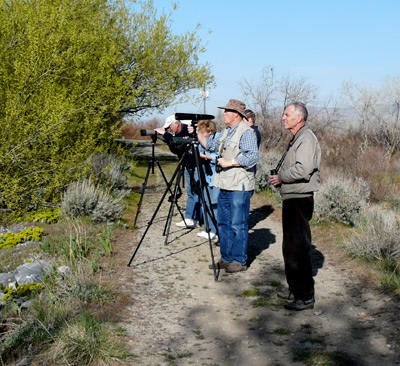 |
|
UCB on Provo Airport Dike - 28
April 2008 |
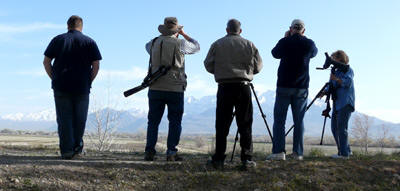 |
|
UCB on Provo Airport Dike - 28
April 2008 |
Field Trip Report
Provo Airport Dike - 28 April 2008
by Lynn Garner
Monday morning at 8:00, eight birders met at the east end of the Provo Airport dyke road for a field trip. Superb weather made it a great day for birding. We were greeted as we met by a pair of Eurasian Collared Doves and when we returned at 11:45, we were greeted by flyovers of a Swainson's Hawk and a Sharp-shinned Hawk . Perhaps the best sighting was a flock of Marbled Godwits flying over at the southwest corner of the dyke. In all we observed 60 species:
Pied-billed Grebe, Eared Grebe, Western Grebe, Clark's Grebe, American White Pelican, Double-crested Cormorant, Great Blue Heron, Great Egret, Snowy Egret, Black-crowned Night Heron, Canada Goose, Gadwall, Mallard, Cinnamon Teal, Northern Shoveler, Redhead, Osprey, Northern Harrier, Sharp-shinned Hawk, Swainson's Hawk, Red-tailed Hawk, American Kestral, Ring-necked Pheasant, American Coot, Sandhill Crane, Killdeer, Black-necked Stilt, American Avocet, Willet, Marbled Godwit, Long-billed Dowitcher, Franklin's Gull, California Gull, Caspian Tern, Eurasian Collared Dove, Mourning Dove, Western Kingbird, Black-billed Magpie, Tree Swallow, Northern Rough-winged Swallow, Barn Swallow, Black-capped Chickadee, Marsh Wren, Ruby-crowned Kinglet, American Robin, European Starling, Yellow Warbler, Yellow-rumped Warbler, Green- tailed Towhee, Brewer's Sparrow, Savannah Sparrow, Song Sparrow, White- crowned Sparrow, Red-winged Blackbird, Western Meadowlark, Yellow- headed Blackbird, Brewer's Blackbird, Great-tailed Grackle, Brown- headed Cowbird, and House Sparrow.
Those participating in the field trip were Lynn Garner (leader), Wade Miller,
Milt Moody, Carol Nelson, DeLoy Pack, Ben Palmer, Leena Rogers, and Reed Stone.
Lynn Garner
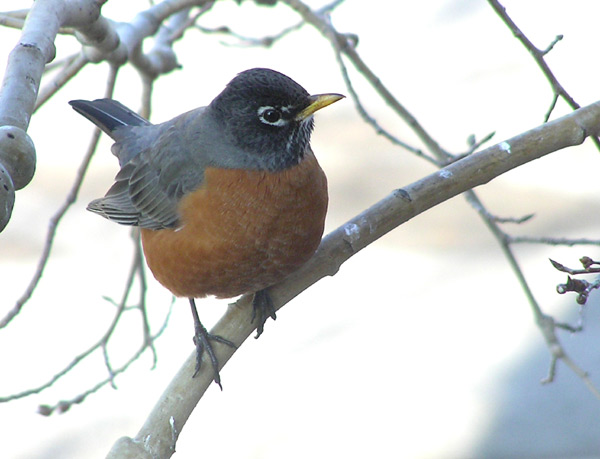 |
|
American Robin - Photo by Eric Huish |
American Robin
by Bonnie Williams
This spring I have enjoyed watching one of our common birds. Several years
ago we planted a Flowering Crab Apple Tree outside of our kitchen window.
Until this year the only thing that took advantage of the All-you-Can-Eat Fruit
Tree were the deer that could only reach part way up. This spring the
American Robin took advantage of our offer. I have had dreams of looking
out of the window and seeing it full of Waxwings (mixed flock of course) but no
luck. Maybe next year, but for now I will enjoy the good old American
Robin, they have to eat just like us common people.
Backyard Bird of the
Month
April 2008
Steve Carr - Holladay
Red-breasted Nuthatch - Pair, still here this late in the Spring.
Yvonne Carter - Highland
Sunday, the 20th, we watched a Cooper's Hawk building a nest in our
taller trees and after 15 minutes I glanced over to the streambed and saw a
Wood Duck and two females swimming by. The Cooper's Hawk left
Tuesday (22nd) and Thurs. the 24th three Lazuli Buntings showed up
amongst the house finches and chickadees.
Flora Duncan - Orem
Lazuli Bunting - first of May, Yard First.
Eric Huish - Pleasant Grove
116 Raptors and Vultures flew over my yard.
Milt Moody - Provo
Virginia's Warbler - a yard lifer.
LeIla Ogden - Orem
Nothing spectacular, but I have enjoyed the White-crowned Sparrows and
the Cassin's Finches that are here in bunches. All the neat birds go to
Bonnie's yard.
Cheryl Peterson - Provo
Broad-tailed Hummingbird
Bruce Robinson - West Jordan
A Eurasian Downy Quail - It's migration time and hard to choose!!!
Tuula Rose - Provo
A new yard bird - a Red-naped Sapsucker tapping away on the trunk of a
pine tree.
Dennis Shirley - Elk Ridge
Lark Sparrow - New Yard Bird!
Alton Thygerson - Provo
First time visits ever were: Lazuli Bunting and Brown Creeper.
Merrill Webb - Orem
Cassin's Finch - about 6.
Bonnie Williams - Mapleton
Indigo Bunting - Gorgeous.
We would like you to share your favorite backyard bird each month. Please send
your favorite bird at the end of the month to newsletter@utahbirds.org or call
360-8777.
DUES
For you faithful members who have always paid dues, but haven't as yet made the
leap this year, the doors to the treasury are still open. For
any wannabe members, they are also open. 2008 dues are $15.00.
Make a check to Utah
County Birders and mail it to:
Carol Nelson
2831 Marrcrest West
Provo, Utah 84604